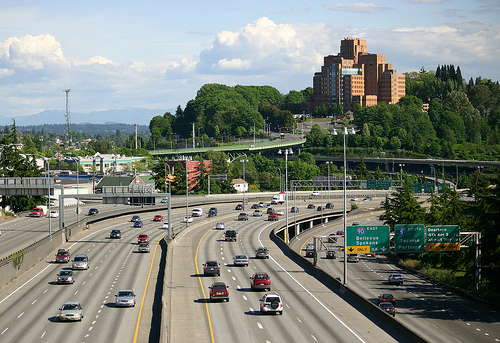The Transportation Experience in America
A Research Guide

Introduction
In any cultural examination of the United States (and, by extension, all of the Western world), the mobility of its people is a concept that plays a prominent role. Indeed, one might say that one of the essences of the so-called American Dream is the freedom to travel, relocate and otherwise move about at will. That the United States, for the first half of its lifetime, was in a constant state of expansion has no doubt informed the collective identify of its residents. Concomitant with this expansion has been the proliferation of a formidable infrastructure, which allowed for the birth of the suburban phenomenon in the late 20th century. Finally, perhaps the crux of this examination is the American preoccupation with the automobile as a ubiquitous accessory, a status symbol and indeed, a stark necessity for many.
This research guide aims to support a number of diverse inquiries. First, how did Americans come to be dependent on the automobile, and why does this dependency persist despite economic realities and environmental concerns? Second, how can one characterize mass transit systems in American cities, vis à vis those of urban centers elsewhere in the globe, which many consider far superior in quality? Third, how have travel and mobility become inextricably linked to Americans’ sense of freedom and independence? These are but a few possible starting points for inquiry. Most importantly, the resources contained within this guide should elucidate the perspective of the individual consumer. Texts written from the point of view of industry and government are of secondary importance here. Given the interdisciplinary nature of this topic, there is no shortage of resources which approach the topic from such disparate disciplines as business, engineering, environmental science and political science. While such resources are of tangential interest, they are not the primary focus here. Lastly, though historical perspective is undoubtedly important, resources which discuss the present and future alongside the past have been preferred.
This guide is geared for a fairly wide audience, and is suited for the casual researcher as well as the undergraduate (and possibly graduate) student. Texts which are either overly academic in style (e.g. doctoral dissertations), or overly popular in tone (e.g. magazine articles) have been set aside in favor of those which balance the scholarly with the accessible. In an effort to distill these vast literatures into a concise list of resources, several methods have been employed. Resources have been evaluated on their own merits, taking into account such criteria as citation count, currency and pre-eminence of author(s); in addition, they have been examined in context with each other, with a view to presenting resources which complement each other as well as possible.
This guide was compiled in partial fulfillment of the course requirements for S501 - Reference. For more information on this and other courses, visit the SLIS home page. Use the links on the right side of the page to browse the various sections.